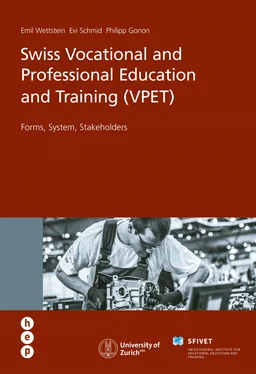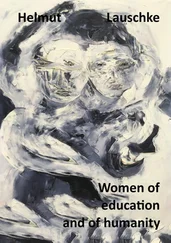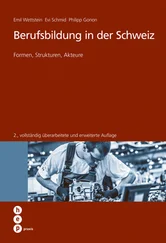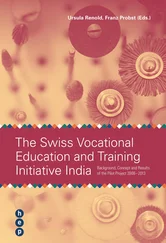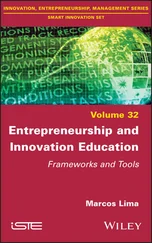In the 1990s, as the universities of applied sciences (Fachhochschulen) were being established and in view of the increasing demand for academic graduates or people with a tertiary education, the former vocational upper-secondary school with an extended general education syllabus (Berufsmittelschule) was expanded to prepare for the Federal Vocational Baccalaureate (FVB). The aim was to enable access to a university of applied sciences without taking an exam.
The Federal Vocational Baccalaureate or FVB (Berufsmaturität, BM) is defined as an extended and in-depth general education as a complement to VET (cf. portrait of Lukas Signer, p. 48). A Federal VET Diploma is an integral part of the FVB qualification. The Federal Vocational Baccalaureate is, therefore, awarded to candidates who have a Federal VET Diploma and have successfully completed the supplementary general education courses for the Federal Vocational Baccalaureate Examination.
The original concept envisaged above all preparatory courses for the Federal Vocational Baccalaureate alongside an apprenticeship: in additional lessons to the regular VET programme more time was to be spent on general education. In the meantime, a second form has been increasing in significance: full-time Federal Vocational Baccalaureate preparatory courses (with a part-time variant) are attended after completion of a VET programme. This consecutive form, in contrast to the Federal Vocational Baccalaureate during an apprenticeship or FVB 1 (BM 1), is called FVB 2 (BM 2) (cf. Fig. 1-6).
The Federal Vocational Baccalaureate was originally subdivided into six orientations: Engineering; Commerce; Handicraft; Art; Natural Sciences; Health and Social Care. According to the new Federal Ordinance on Baccalaureates (Berufsmaturitätsverordnung) from 2009, for all graduates the FVB comprises four areas which are specified in the core syllabus from 2013: a fundamental area, an area of focus, a supplementary area and interdisciplinary work.

Figure 1-6: Development of the Federal Vocational Baccalaureate during an apprenticeship (FVB 1) and the Federal Vocational Baccalaureate after a VET programme (FVB 2). Source: FSO (2011b); representation and additions by the authors
There are around 200 schools which offer FVB 1 or FVB 2: vocational schools, commercial schools, trade schools and individual private schools.
Since 2005 there have also been preparatory courses for the University Aptitude Test (UAT) for enrolment in a Swiss cantonal university, a federal institute of technology (FIT) or a university of teacher education (UTE). In 2015, a total of 773 Federal Vocational Baccalaureate holders used this transition from the Federal Vocational Baccalaureate to academic studies at a university (Federal Statistical Office; FSO, 2016b).
In 2015, a total of 14,000 Federal Vocational Baccalaureates (FVB) were issued. 11.7 per cent of all learners obtained their FVB qualification parallel to the Federal VET Diploma (FVB 1), another 10.3 per cent obtained their FVB after completion of a VET programme (FVB 2) (FSO 2016b). Two years after completion of an FVB, only 50 per cent of FVB holders have enrolled at a university of applied sciences, however. The impressive rise of the Federal Vocational Baccalaureate in a short period of time and its prominent role alongside the general education baccalaureate conflicts with a clearly lower transition rate than was expected. The favourable labour market situation possibly plays a role in the fact that many Federal Vocational Baccalaureate holders do not opt to study at a university of applied sciences or delay the decision until later (Gonon, 2013, p. 129).
PORTRAIT OF LUKAS SIGNER
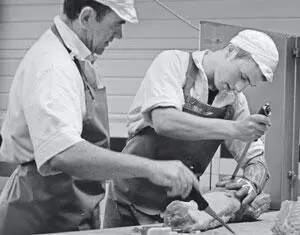
Lukas Signer, 17,
is studying for the Federal Vocational Baccalaureate alongside his VET programme
clear
People achieve nothing without hard work
“Vocational training needs smart learners, too,” says master butcher Franz Fässler. For two years, he has been training a meat specialist (Fleischfachmann) who is attending preparatory courses for his Federal Vocational Baccalaureate and is, therefore, absent from the butcher’s shop more often than Fässler would sometimes like.
He sometimes hears a voice groaning inside him, at around five in the morning. At this time, 17-year-old Lukas Signer is sitting on a bike, there are eight kilometres between Jakobsbad and Appenzell, and his body is freezing with the cold of the night. Why am I doing this to myself, the voice asks, why did I choose a profession with such working hours? When he arrives at his host company, Lukas Signer knows the answer: “I am learning to be a meat specialist. We produce up-market, high-quality food. I like that.” Usually, the day begins with the production of sausages. “At seven, when other craftspeople are just starting their work, we have already accomplished a lot.” Then, Lukas Signer sits down for breakfast, together with the staff, up in his boss’s apartment. He has been warm for a long time.
Lukas Signer knows that people achieve nothing without hard work. As well as the VET programme, he attends the courses for the Federal Vocational Baccalaureate (FVB), which means a lot of additional work. On Tuesdays and on Wednesday afternoons, he attends the vocational school offering a preparatory course for the Federal Vocational Baccalaureate Examination (Berufsmaturitätsschule or BMS) at the Gewerbliches Berufs- und Weiterbildungszentrum St. Gallen (St. Gallen Vocational and Continuing Education Centre) – eleven lessons in total – and he spends Wednesday mornings at the vocational school in Winterthur. On the other three days, Lukas Signer works in the company, sometimes also on Saturdays. His apprenticeship trainer Franz Fässler says: “The Federal Vocational Baccalaureate is very important for vocational training. It is unacceptable for all talents to go to upper-secondary level baccalaureate schools. This requires that we, as a company, make a sacrifice by giving up our time. And it requires also compromises from the learners: on around ten Saturdays a year, Lukas Signer helps out when we need the staff.”
At the moment, Lukas Signer is boning meat, next to him his boss is doing the same work. With pinpoint accuracy the knives separate bone from meat and remove excess layers of fat, and with pinpoint accuracy the processed pieces find their way into the containers. Sometimes the apprenticeship trainer Franz Fässler stands beside Lukas Signer and gives him tips: to separate the skin from bone, the sharpening steel is more suitable than the knife because it does not damage the skin. Lukas Signer is grateful to be given such advice: “I am not yet fast enough, and speed is important, not least in the final examination. People notice that I am at school more often than others.” But the young butcher does not doubt that the FVB makes sense because it gives him the opportunity to study at a university of applied sciences, even if at the moment he is thinking more of becoming self-employed. Yet he would choose the FVB during an apprenticeship again.
“My knowledge of English and French is limited. With the FVB after the apprenticeship I would have been left by the wayside in these subjects,” he explains. In the VET programme of his profession, Lukas Signer does not learn any foreign languages.
The subjects at the FVB school do not have any direct relation to his profession, says Lukas Signer. Together with him, chefs, digital printing specialists and a pharmacist are acquiring the FVB, and in some subjects like English, mathematics and history, the class of seven people is joined by learners from the health care and social work VET programme. “It is even more complicated,” says Lukas Signer: “The FVB class in the first apprenticeship year consists of only two learners. Now, they usually attend school together with us, in a separate room. The teacher teaches at both locations and hands out assignments alternately.” The solutions for the tasks can be found on the internet.
Читать дальше
